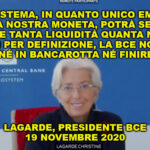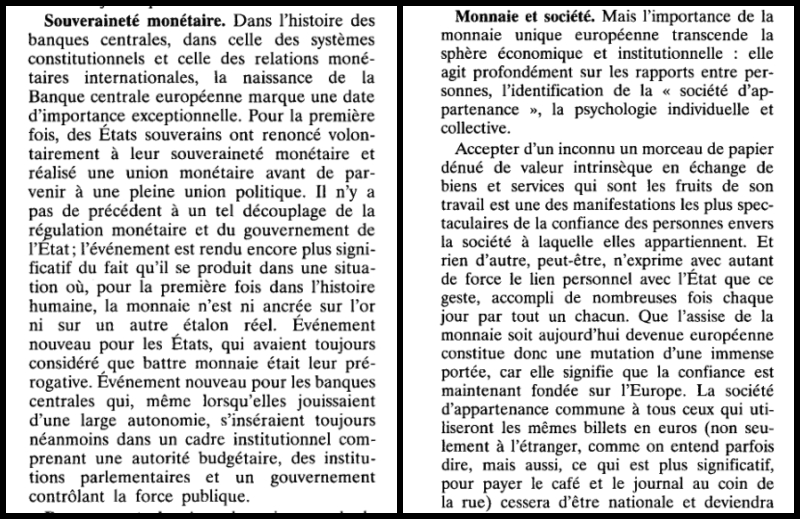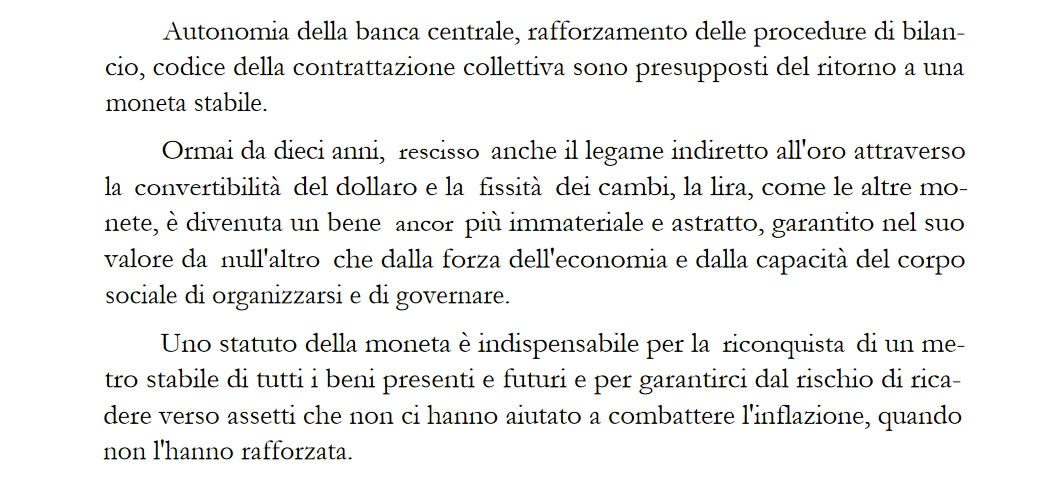The truth about the issuance of money, word of the central bank

In the age of the blackout of reason, reiterating the obvious is a revolutionary act.
The " scarcity of money " is one of the most repeated mantras of the last 30-40 years: money is little , being little it cannot be wasted , so you have to tighten your belt, make sacrifices .
People have internalized the dogma of " there is no money ", because TV, newspapers and politicians have repeated it ad nauseam, but is this really the case?
Over the years, various statements have been made by representatives of central banks , regarding the real nature of the currency, its issue and what its value depends on.
Let's make a brief recap.
DO CENTRAL BANKS SPEND TAX MONEY? NO
Let's start with the United States of Amerca. Here are two statements by two presidents of the FED, translated into Italian by the RAI broadcast " The Last Word " on November 9, 2012 .
Here is the clip, which is found shortly after 1 hour of transmission.
Bernanke Greenspan the last word 9 November 2012 rai comparison 2
The first is that of Ben Bernanke , chairman from 2006 to 2014, registered on CBS on March 15, 2009 .
Below the original English clip, from 7:58
QUESTION : « But are you spending taxpayers' money ? "
BERNANKE : “ It's not taxpayers' money. Banks have accounts with the Federal Reserve, just as you have an account with a commercial bank. To lend to banks, we simply use computers to augment their Federal Reserve accounts . Kind of like printing money, rather than lending it. "
QUESTION : "Are you printing money …"
BERNANKE : “ Indeed, but we have to do it because the economy is very weak and inflation is low . "
And now the transcription of that of Alan Greenspan , Bernanke's predecessor, made on 7 August 2011 in the show "Meet the press" (here the complete transcription )
When asked about the safety of US government bonds , following a " downgrade " by Standard & Poor's , Greenspan replied as follows:
David Gregory : "Are US treasury bonds still safe to invest in?"
Alan Greenspan : “Very much so. This is not an issue of credit rating, the United States can pay any debt it has because we can always print money to do that. So, there is zero probability of default. "
QUESTION : « Are US State Bonds still a safe investment? "
GREENSPAN : « Sure. The problem is not the rating agencies, the United States can always honor its public debt because we can always print money to pay for it . Thus, the chances of the US defaulting are zero. "
And while in Italy we were under pressure from the spread , Greenspan sent S&P to that country.
Since there is no two without three, current President Jerome Powell also recently made interesting statements. Powell is facing the covid emergency , where will he have "found" the money to support the American economy?
On May 17, 2020 the "chaimar" was interviewed in the show "60 minutes". Here is the full transcript , under the video of the intervention.
PELLEY : Fair to say you simply flooded the system with money?
POWELL : Yes. We did. That's another way to think about it. We did.
PELLEY : Where does it come from? Do you just print it?
POWELL : We print it digitally. So as a central bank, we have the ability to create money digitally . And we do that by buying Treasury Bills or bonds for other government guaranteed securities. And that actually increases the money supply. We also print actual currency and we distribute that through the Federal Reserve banks.
QUESTION : “ Is it fair to say that you simply flooded the system with money ? "
POWELL : “ Yes. We did it. This is another way of thinking about it. We did it. "
QUESTION : « Where does it come from? Do you just print it ? "
POWELL : « We print it" digitally ". So, as a central bank, we have the ability to create money digitally . And we do this by buying treasury bills or bonds for other government-backed securities. And this actually increases the money supply . We also print "real" money and distribute it through Federal Reserve banks. "
CAN A CENTRAL BANK EVER END YOUR MONEY? NO
Some time ago, in the article " 5 incredible admissions made by the ECB ", he remembered the famous answer of Mario Draghi to the question "if the ECB could ever run out of money".
Let's listen to those words of January 9, 2014 , the response of the then governor had a very embarrassed tone.
Well, technically no… We are, we don't, we don't, we cannot run out of money …. So we, we have ample resources for coping with, with all, with all our emergencies …. So I think this is the the only answer I can give you.
« Well, technically not… we can't run out of money . So we have ample resources to meet all our needs . I think this is the only answer I can give you. "
In 2019, however, the ECB came out with this tweet , when asked where they "found" the money for Quantitative Easing (QE). The response this time was much clearer.
Praet : as central bank, we can create money to buy assets #askECB
" As a central bank, we can create money to buy assets "
And just in these days, President Lagarde in a parliamentary question on November 19, 2020 , has released these incredible statements.
As the sole issuer of euro-denominated central bank money, the eurosystem will always be able to generate additional liquidity as needed. So by definition, it will neither go bankrupt nor run out of money
« The Eurosystem, as the only issuer of our currency, will always be able to generate as much liquidity as it needs. So by definition the ECB cannot go bankrupt or run out of money "
The full video conference can be found in this link , the speech is at 9:55 am in response to the question of the MEP Marco Zanni .
But a month earlier, this concept had already been reiterated by Eugenio Gaiotti (head of the Economics and Statistics Department of the Bank of Italy), on 12 October 2020 in response to a question from Alberto Bagnai .
Senate Alberto Bagnai Eugenio Gaiotti ECB coin issue 12 November 2020 byoblu
BAGNAI «(…) the question referring to the 500 billion was very simple: where did they come from ? That is where the 500 billion that will be used to buy securities come from .
Why does someone claim they come from tax collection , can you clarify if they come from there, or where they come from? Where does the ECB "find" these billions? All here "
GAIOTTI « This is a monetary policy decision, which means: it is a matter of issuing money , which is what a central bank does.
I am not aware of anyone arguing otherwise (I apologize for this but), like any central bank , the European central bank buys securities and creates money , creates its own liabilities to support the economy , that's all "
The original video is onthe Senate website , the extract in question is at 1 hour and 15 seconds.
TRUST IN MONEY
In history, the issuance of money has not always been "free", the Bank of England reminds us well in this short video, uploaded to their YouTube channel.
Here is the transcript of the original text
In 1694, when the bank opened, it took deposits of gold coin from its customers. It issued paper receipts, or notes, in return . These were used as convenient ways to pay for things, rather than using gold.
People accepted these notes as a promise to pay , knowing they could them back to the bank at any time in return for gold. These receipts gave to the banknotes we recognize today.
But it's no longer possible to pay in gold. So what gives banknotes their face value? Trust .
We Trust in the promise that our banknotes can be exchanged for the things we want and that they will be accepted for their face value .
Public trust in banknotes is based on the security features that make them difficult to forge and the low inflation that protects their value over time.
“ In 1694, when the bank was founded, it took deposits of gold coins from its customers. In exchange, he issued paper receipts or banknotes . These were used as a more convenient means of paying for things, instead of using gold.
People accepted these notes as a promise to pay , knowing they could return them to the bank at any time in exchange for gold .
These "receipts" gave rise to the banknotes as we know them today. But it is no longer possible to pay in gold. So what gives the banknotes their face value? Trust .
We trust the promise that our banknotes can be exchanged for the things we want and that they will be accepted for their face value .
Public confidence in banknotes is based on the security features that make them difficult to forge and on the low inflation that protects their value over time. "
The question of "trust" was already highlighted by Tommaso Padoa-Schioppa in 1999, who at the time worked on the executive committee of the ECB.
Let's read two passages from his article " The teachings of the European adventure " written in the French magazine " Commentaire ".
« In the history of central banks, in that of constitutional systems and that of international monetary relations, the birth of the European central bank marks a date of exceptional importance.
For the first time, sovereign states voluntarily renounced their monetary sovereignty and achieved full monetary union before reaching full political union.
There is no precedent for such a detachment from monetary regulation and state government; the event is made even more significant by the fact that it occurs at a time when, for the first time in human history, money is anchored neither on gold nor on any other real standard. (…)
Accepting a piece of paper with no intrinsic value from a stranger in exchange for goods and services that are the fruits of his labor is one of the most spectacular manifestations of people's trust in the society to which they belong. "
You can read other pearls of Padoa-Schioppa on “ the confessions of the fathers of the euro ”.
Closed parentheses, we conclude this roundup with the father of the euro par excellence.
MONEY AND REAL ECONOMY
With the end of the Bretton Woods agreements in August 1971, the "modern currency" (or fiat currency) was born, based precisely on people's trust, but above all on the real economy that was supported by that currency.
Carlo Azeglio Ciampi knew this very well, in the conclusions of the annual report on 1980 – made on May 30, 1981 – here is what he declared, towards the end of his speech
" For ten years now, even the indirect link to gold through the convertibility of the dollar and the fixed exchange rate has been terminated , the lira, like other currencies, has become an even more immaterial and abstract asset, guaranteed in its value by null other than the strength of the economy and the ability of the social body to organize and govern . "
With all due respect to the "deniers" of money, the reality is that the shortage of money in the real economy is only a political choice and not an inevitable fact.
Moreover, precisely in this speech, almost 40 years ago, Ciampi "anticipated" the three pillars on which the European monetary union would be based, but this is another story.
ORIGINAL ARTICLE  https://canalesovranista.altervista.org/la-verita-sullemissione-di-moneta-per-bocca-delle-banche-centrali/
https://canalesovranista.altervista.org/la-verita-sullemissione-di-moneta-per-bocca-delle-banche-centrali/

Thanks to our Telegram channel you can stay updated on the publication of new articles of Economic Scenarios.
The article The truth about the issue of money, word of the central bank comes from ScenariEconomici.it .
This is a machine translation of a post published on Scenari Economici at the URL https://scenarieconomici.it/la-verita-sullemissione-di-moneta-parola-di-banca-centrale/ on Mon, 23 Nov 2020 15:47:33 +0000.



